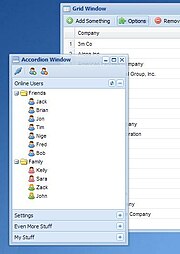Ext JS
| Developer(s) | Sencha |
|---|---|
| Stable release | 4
/ April 26, 2011 |
| Type | JavaScript library |
| License | GPLv3 or commercial |
| Website | http://www.sencha.com/products/js/ |
Ext JS (ee-X-t JS) is a JavaScript library for building interactive web applications[1] using techniques such as Ajax, DHTML and DOM scripting.
Originally built as an add-on library extension of YUI by Jack Slocum, Ext includes interoperability with jQuery and Prototype. Beginning with version 1.1, Ext retains no dependencies on external libraries, instead making their use optional.[2]
Features
GUI controls
Ext JS includes a set of GUI-based form controls (or "widgets") for use within web applications:
- text field and textarea input controls
- date fields with a pop-up date-picker
- numeric fields
- list box and combo boxes
- radio and checkbox controls
- html editor control
- grid cow a form to be divided into multiple sub-sections
- sliders
- flash charts
Many of these controls are able to communicate with a web server using Ajax.
Application support
Ext JS includes web application support with features such as:
- modal dialog boxes
- interactive user-input validation prompts
- state management
Other features include a DOM selector class allowing operations to be performed on elements within the page, data stores that can be used to manage data, and classes to create and manage data in JSON and XML formats.
Ext JS 2.0
Ext JS version 2.0 was released on 4 December 2007. This version was promoted as providing an interface and features more similar to those traditionally associated with desktop applications. Also promoted were the new user documentation, API documentation, and samples.[3]
Ext JS 2.0 did not provide backward compatibility with version 1.1. A migration guide was developed to address this.[4]
Ext JS 3.0
Ext JS version 3.0 was released on 6 July 2009. This version added communication support for REST and a new Ext.Direct server side platform. New flash charting and ListView elements were added to the standard display components. It was backwards compatible with version 2.0 code.
Ext JS 4.0
Version 4.0 of the Ext framework was released on April 26th, 2011. It includes a completely revised class structure[5], a revised data package, an animation and drawing package that uses SVG and VML[6], and revised charting and theming. It also includes an optional architecture that provides a Model-View-Controller style of code organization.
Sencha
On 15 June 2010, the merger of Ext JS with JQTouch and Raphaël was announced[7] forming a new organisation called Sencha Inc.. Ext JS continues to be available as a main product on the new Sencha website[8] together with Sencha Touch, Ext GWT, Ext Designer, Sencha Animator and Ext Core.
License history
YUI-Ext was available under the BSD license. In 2008 the open source license associated with Ext was changed. In version 2.0.2, the authors stated that Ext was available under an LGPL-style license as long as you "plan to use Ext in a personal, educational or non-profit manner" or "in an open source project that precludes using non-open source software" or "are using Ext in a commercial application that is not a software development library or toolkit". This was no longer the case with Ext 2.1.[9] Some people[who?] claimed that the license conditions as the authors described it stood while others[weasel words] claimed that clause 7[10] of the LGPL-style license enabled the software to be used by all regardless of Ext's conditions. The Ext authors claim that section 7 of the LGPL as it is worded does not apply to "conditions" which their license requires before distribution under the LGPL is permitted as opposed to "additional restrictions" which section 7 allows a distributor to remove.[citation needed]
On 20 April 2008, Ext 2.1 was released under a new dual license which allowed the options of the full GPL 3.0 license or a commercial license.[11]
The change in license over time, from a permissive open source license to a restrictive dual license, caused controversy in the Ext user community.[12][13][14][15]
References
- ^ (see also, Rich Internet application
- ^ Ext as of version 2.0 can works with different base libraries or adapters. (e.g. YUI, jQuery, Prototype), or it can work standalone.
- ^ API documentation includes a migration guide. http://extjs.com/deploy/dev/docs/
- ^ Ext 1 to 2 Migration Guide - Sencha - Learn
- ^ Countdown to Ext JS 4: Dynamic Loading and New Class System | Blog | Sencha
- ^ Countdown to Ext JS 4: Data Package | Blog | Sencha
- ^ Ext JS + jQTouch + Raphaël = Sencha | Blog | Sencha
- ^ Ext JS overview on Sencha.com http://www.sencha.com/products/js/
- ^ ExtJS forum thread on the license change
- ^ http://www.gnu.org/licenses/lgpl-3.0.txt
- ^ Ext JS 2.1 and Ext GWT 1.0 released, preview of Ext JS 3.0 | Blog | Sencha
- ^ License Fake-out hits ExtJS and Java Service Wrapper: Communities Alienated - O'Reilly ONJava Blog
- ^ ExtJS: When open source is not open at all | The Open Road - CNET News
- ^ Ext JS and the fun with Open Source licenses - Ajaxian
- ^ Brewing Controversy Surround EXTJS « The Byte Stops Here
Bibliography
- Orchard, Leslie M.; Pehlivanian, Ara; Koon, Scott; Jones, Harley (August 31, 2009). Professional JavaScript Frameworks: Prototype,YUI, ExtJS, Dojo and MooTools (1st ed.). Wrox Press. p. 888. ISBN 978-0470384596.
- Frederick, Shea; Ramsay, Colin; 'Cutter' Blades, Steve (November 28, 2008). Learning Ext JS (1st ed.). Packt Publishing. p. 299. ISBN 978-1847195142.
- Garcia, Jesus (Summer 2010). Ext JS in Action (1st ed.). Manning Publications. pp. 495 (est). ISBN 978-1935182115.
External links
- Sencha Web site
- Additional Examples site
- Sencha forum
- Sencha Documentation
- Tutorials about ExtJS 4 from scratch

